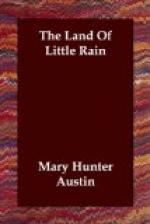Cattle, when there are any in the Ceriso, drink morning and evening, spending the night on the warm last lighted slopes of neighboring hills, stirring with the peep o’ day. In these half wild spotted steers the habits of an earlier lineage persist. It must be long since they have made beds for themselves, but before lying down they turn themselves round and round as dogs do. They choose bare and stony ground, exposed fronts of westward facing hills, and lie down in companies. Usually by the end of the summer the cattle have been driven or gone of their own choosing to the mountain meadows. One year a maverick yearling, strayed or overlooked by the vaqueros, kept on until the season’s end, and so betrayed another visitor to the spring that else I might have missed. On a certain morning the half-eaten carcass lay at the foot of the black rock, and in moist earth by the rill of the spring, the foot-pads of a cougar, puma, mountain lion, or whatever the beast is rightly called. The kill must have been made early in the evening, for it appeared that the cougar had been twice to the spring; and since the meat-eater drinks little until he has eaten, he must have fed and drunk, and after an interval of lying up in the black rock, had eaten and drunk again. There was no knowing how far he had come, but if he came again the second night he found that the coyotes had left him very little of his kill.
Nobody ventures to say how infrequently and at what hour the small fry visit the spring. There are such numbers of them that if each came once between the last of spring and the first of winter rains, there would still be water trails. I have seen badgers drinking about the hour when the light takes on the yellow tinge it has from coming slantwise through the hills. They find out shallow places, and are loath to wet their feet. Rats and chipmunks have been observed visiting the spring as late as nine o’clock mornings. The larger spermophiles that live near the spring and keep awake to work all day, come and go at no particular hour, drinking sparingly. At long intervals on half-lighted days, meadow and field mice steal delicately along the trail. These visitors are all too small to be watched carefully at night, but for evidence of their frequent coming there are the trails that may be traced miles out among the crisping grasses. On rare nights, in the places where no grass grows between the shrubs, and the sand silvers whitely to the moon, one sees them whisking to and fro on innumerable errands of seed gathering, but the chief witnesses of their presence near the spring are the elf owls. Those burrow-haunting, speckled fluffs of greediness begin a twilight flitting toward the spring, feeding as they go on grasshoppers, lizards, and small, swift creatures, diving into burrows to catch field mice asleep, battling with chipmunks at their own doors, and getting down in great numbers toward the lone juniper. Now owls do not love water greatly on its own account. Not to my knowledge




